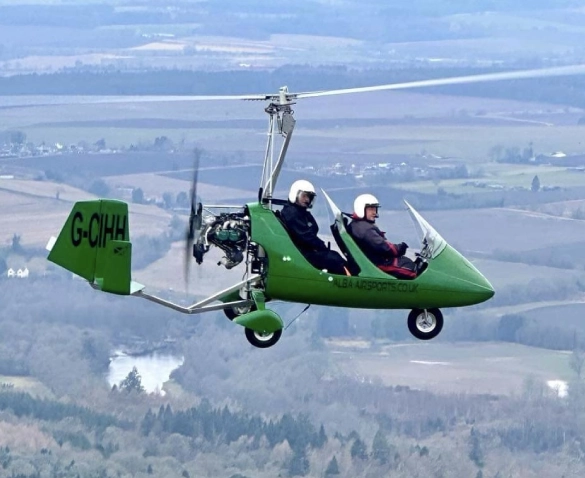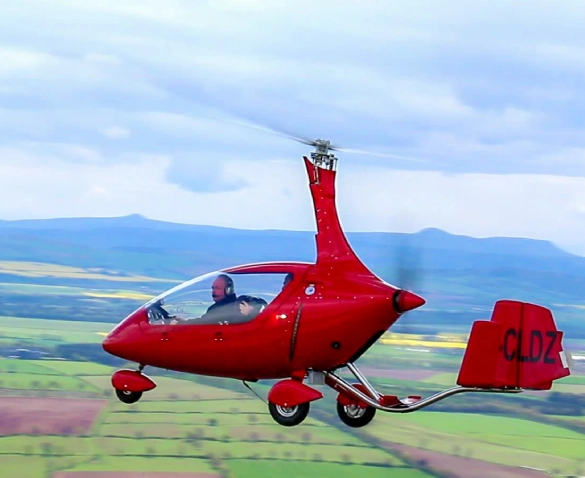Known as the motorbike of the sky, you'll have great fun in this aircraft.
Whether just an air experience flight, or learning to fly
Operating from the Scottish Aero Club at Perth Airport, Alba Airsports can offer you gyrocopter flight training in modern open-cockpit gyrocopters, and experience flights in both open cockpit and enclosed-cockpit gyrocopters. We offer both flight training by the hour, and intensive training courses for ab-initio and converting pilots.
Maximum take-off weight 500 kgs
Empty weight: 278 kg
Engine: Rotax 912 ULS 100HP 4 Stroke.
Takeoff distance: 70 to 150 meters
Max endurance: 4 hours
Max range: 250 miles
Cruise speed: 80 mph
Max speed (VNE) 120 mph
Fuel capacity: 70ltr
Compliant with: CAA BCAR Section T


Maximum take-off weight 560 kgs
Empty weight: 309 kg
Engine: Rotax 914 UL 115HP 4 Stroke.
Takeoff distance: 70 to 150 meters
Max endurance: 4 hours
Max range: 250 miles
Cruise speed: 80 mph
Max speed (VNE) 120 mph
Fuel capacity: 75ltr
Compliant with: CAA BCAR Section T.
(This aircraft is not available for pilot training)
As well as pre-booked training by the hour, Alba Airsports also offers an option of 5-day intensive training courses for student pilots. Courses cater for students who want to train for a Private Pilot’s Licence for Gyroplanes or PPL(G) in addition to advanced flying training for existing pilots. Training courses are held during the week with a maximum of two students on each intensive training week. Students take it in turns to fly and depending on their stage of training, may share briefings.
During intensive training you can expect to fly an average of two and a half hours each day. Learning to fly is very intense and it takes a while for your brain to assimilate what you’ve been taught so it’s important to build in rest time. We discourage students from booking intensive training weeks back-to-back because it isn’t the most productive way to learn. You need time to fully understand and absorb everything you’ve learned. The optimum gap between training weeks is between one and four weeks, however, it is not unusual to have students who are learning to fly over a couple of years and have longer gaps between each intensive week.
We fully understand and respect that you will probably use valuable free time in learning to fly and we make every effort to fly despite sometimes less than ideal weather conditions. We will sometimes rearrange the order that things are taught to make the best use of the varying British weather conditions. When flying is not possible we switch our attention to the various ground school topics to ensure that time isn’t wasted.
Feedback has shown that it can be extremely beneficial to immerse yourself in training when learning to fly and our intense training courses are designed. However, if it is not possible for you to enrol in an intensive course, we will work with you to deliver a training programme via shorter lessons over a longer period.
Anyone. Individuals who are reasonably fit and within the weight and height limits.
We conduct flight training towards a PPL(G) Private Pilots Licence (Gyroplane).
The minimum Flight training requirements are as follows:-
Minimum flight time total of 40 hours.
Minimum dual instruction of 15 hours.
Minimum solo flight time of 10 hours, including a minimum of 3 hours cross-country navigation flight.
In addition to flying time, students are required to sit 5 written examinations on the following subjects:-
Air Law – Meteorology – Human Performance & Limitations – Navigation – Gyroplane Technical
On completion of training the student will be required to conduct a Flying Skills test and a ground oral examination conducted by a CAA -qualified flight and ground examiner.
Medical:-
The medical requirements to become a microlight pilot are similar to those required to drive a car. You simply need to complete a Civil Aviation Authority private medical declaration. This can be done on the CAA’s customer portal and is recommended to be completed before commencement of training, and is mandatory before any solo flights take place.
N.B. Some medical conditions may require referral to an Aero Medical Examiner.
Discover the Thrill of Gyrocopter Aviation Today!
Copyright Alba-Airsports © 2025 All Rights Reserved
